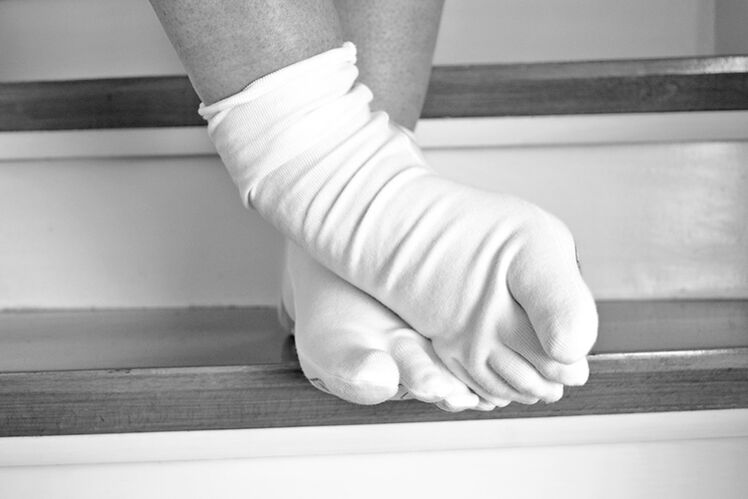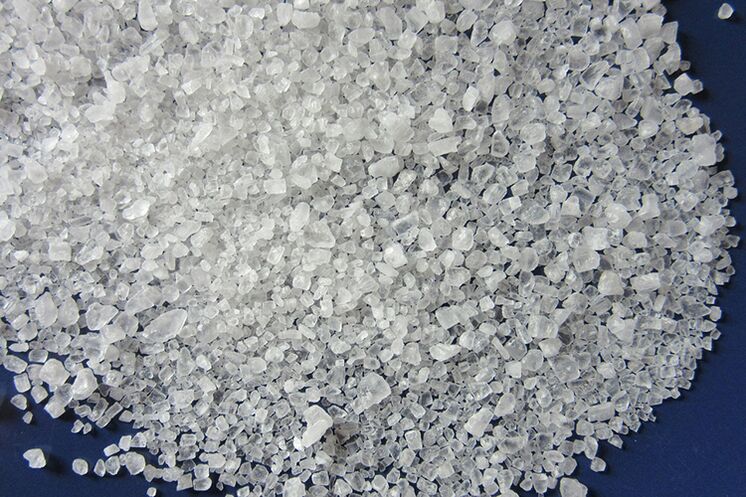Skin mycoses are a common group of diseases. Patients do not always take it seriously enough, which leads to an advanced form of pathology that is difficult to treat. Fortunately, there are many ways to get rid of fungal infections on your feet and get rid of nasty diseases like fungal infections on your toes and feet.
Patients do not always take it seriously enough, which leads to an advanced form of pathology that is difficult to treat. Fortunately, there are many ways to get rid of fungal infections on your feet and get rid of nasty diseases like fungal infections on your toes and feet.
Mycosis of the skin between the fingers - how does this disease occur?
Skin mycosis is an infectious disease caused by a fungus that infects the skin. They can appear anywhere on the body. But more often than not, they choose skin folds. The space between the toes is their favorite place. This is due to the fact that the feet often sweat, and on tight shoes moisture does not have time to evaporate. Therefore, the distance between the fingers is often wet and damp. And this condition is what the fungus needs for reproduction. It is not uncommon for fungus to enter the indentations between the fingers of an infected nail.
Contributes to the development of skin diseases:
- inadequate foot hygiene, overheating or hypothermia;
- increased tendency to sweating;
- poor blood circulation in the legs associated with heart disease, smoking, diabetes mellitus;
- pressure;
- calluses and wounds on the skin of the feet;
- lack of vitamins and minerals (especially zinc) in the body;
- trophic ulcers on the legs;
- hormonal imbalances and thyroid disease;
- overweight;
- excessively dry skin.
However, in most cases, the fungus between the toes does not develop if the person has healthy immunity.
The disease is more common in men, due to wearing tight shoes. Fungus on the feet can appear not only in adults, but also in children.
Mycoses of the skin between the toes in 90% of cases are caused by the activity of three types of fungi from the group of dermatomycetes - Trichophyton, Microsporum, Epidermophyton. Also, often the skin in the interdigital space is affected by fungi of the genus Candida.
Often, the infection initially develops in the cavity between the two smallest toes. However, other interdigital spaces may also be affected. Once on the skin, the fungus actively multiplies on it. The remnants of the skin stratum corneum serve as food for microorganisms.
Skin infections can spread from person to person. For this, a moderate contact of the skin of the foot with the surface containing the fungus is sufficient. The spread of pathogens can occur with the help of shoes, socks, shared towels, and wet floors in other people’s bathrooms. It is necessary to monitor personal hygiene carefully, using only personal items. In the pool, shower, bath and sauna, personal or disposable slippers and slippers should be used.

Often, skin diseases are transmitted from one family member to another, by using shoes, pedicures, socks, towels, similar items around the house with bare feet, etc.
Symptoms of fungal infections on the skin of the feet.
Symptoms of foot mycosis in the early stages:
- itching and burning, worse at night;
- drought;
- peeling skin;
- small cracks.
With the progression of the disease, symptoms increase, itching and burning become unbearable, causing scratches and irritation on the skin, cracks become deeper. The skin of the feet becomes rough. Pain appears, an unpleasant odor that is impassable even after washing, edema and hyperemia, there is a discharge of the epidermis.
Then a bubble filled with serous fluid appears. Upon opening it, the unhealed festive boil remains on the skin. Bacteria accompany mycotic infections.
Peeling nails, abscesses may appear. Complications of foot mycosis can be the penetration of the fungus into the bloodstream and the spread of infection throughout the body. At the same time, body temperature rises. Gangrene lesions on the legs can also develop. Cardiovascular disease, immunodeficiency conditions, and diabetes mellitus complicate the course of skin disease.
To diagnose foot mycosis, the doctor may not examine the skin. It is often necessary to analyze the composition of the skin microflora. For this, abrasion is taken from the affected surface. Fungus can be found on the skin although no symptoms of infection can be seen.
There are also popular methods for determining the presence of fungus on the feet. To do this, you need to put your feet in a bath of potassium permanganate. If there is no fungus on the skin, then it will turn pink, and the affected area will turn white.
How to get rid of fungus between the toes?
Getting an infection on your skin is very easy, but getting rid of it is much harder. Skin mycoses are always treated at home, but this does not mean that patients will definitely be helped by a completely independent treatment. In any case, a doctor's advice is needed.
There are many antimycotic drugs that are effective in killing fungi. However, the success of treatment is highly dependent on the stage of the disease. If he is too far away, it is difficult to get rid of the infection. In the early stages, external antifungal drugs are used. If the disease is already underway, then the doctor recommends treating with systemic methods. Most often, terbinafine, itraconazole, fluconazole are prescribed in tablet form.
Popular antifungal agents:
- nystatin,
- fluconazole,
- ketoconazole,
- clotrimazole,
- terbinafine,
- naftifine,
- mikonazol,
- itraconazole,
- natamycin.
Some antifungal ointments also contain anti-inflammatory ingredients.
The method of application of all ointments is the same - it must be applied regularly to the affected skin area with a thin layer. Some ointments are sufficient to use once a day, others require more frequent use. An antifungal spray that can be sprayed onto the affected area is easier than an ointment.
Treatment with antifungal ointment can last a long time. Certain types of ointments can get rid of the infection after 2 weeks. But with severe damage, the treatment period can take up to 3 months. Doctors advise to use the ointment at least 2 weeks after the visible symptoms of the disease have passed. And once every six months, it is necessary to lubricate the toes with ointment for preventive purposes.
Also, with severe infections, systemic antifungal medications can be used. However, they have a long list of contraindications and side effects. In particular, pills for fungus are contraindicated in pregnant women. Also, many skin ointments are prohibited during pregnancy. If there is a need to use such topical preparations, it is necessary to consult a doctor. Not all medications are allowed in childhood. Therefore, you need to see the instructions for the selected tool. Some drugs can be used from the age of 2 years, others from the age of 12 years.
The specialist must choose the right medication. Improper use of antimycotic drugs will not only not relieve the patient from pathogenic microorganisms, but can also lead to the development of resistance in them (especially in situations when the patient is constantly re -infected). Toxins released by many fungi suppress local immunity, which contributes to the development of infections.
In addition, vitamin and mineral complexes are taken. If the disease is complicated by a bacterial infection, the doctor prescribes antibiotics, but if there are signs of allergies, antihistamines are prescribed. Treatment can be supplemented with anti-inflammatory ointments, salicylic, sulfuric, ichthyol and zinc ointments.
Salicylic ointment:
- has antiseptic properties,
- prevent skin keratinization,
- promotes epidermal recovery,
- prevent the spread of infection.
Zinc ointment contains lanolin, menthol, zinc oxide. Zinc ointment has disinfectant properties, stimulates skin regeneration, relieves itching and burning.
Sulfur ointment has anti-inflammatory, emollient and disinfectant properties. Ichthyol ointment has keratolytic, anti-inflammatory, bactericidal effect. Also, ichthyol ointment promotes tissue regeneration.
Don't forget foot hygiene as well. You need to take off tight and uncomfortable shoes, socks and synthetic socks, regularly change the soles. Shoes must be disinfected with antimycotic spray. Indeed, the treatment will have no effect if the patient’s skin continues to be infected with new parts of the fungus that live in the shoe.
Fungus between the toes: treatment with folk remedies at home
Treatment with pharmaceutical preparations does not always bring the desired effect. Therefore, people turn to folk remedies. This approach is also understandable because many synthetic antimycotic ointments and sprays are not necessarily cheap. Treatment with folk remedies can be done in addition to treatment with pharmaceutical skin ointments.
The easiest folk remedies to get rid of fungus are bath salts and soda. To prepare the tray, you need 2-3 tablespoons of salt or soda per 5 liters. air. Water temperature- + 40-45 ° C. The duration of the procedure is 15-20 minutes.

One of the best home remedies is an herbal bath with antiseptic properties. It can be chamomile, sage, calendula, nettle, St. John's wort. John's wort. To prepare the bath, you need 2-3 tbsp. plant material (you can take a mixture of various ingredients) insist in a glass of boiling water, strain and add to a 5 liter container with water for bathing. The water must be warm, but not burn the skin of the feet. The duration of the procedure is 15-20 minutes.
Many people when there is fungus on the skin of the feet are also helped by bathing with a solution of potassium permanganate. To prepare a light pink solution, only a few grains of potassium permanganate are needed. You can also moisten a piece of cotton wool with a solution of potassium permanganate and stick it between your fingers.
Boric acid is also effective in treating diseases. You can use dilute boric acid and powder. Acid can be added to the bath and treated in the affected area.
For the balance, you can also use a slightly warm 9% table apple cider vinegar solution. The duration of the procedure is 15 minutes. You can also make a vinegar lotion.
Another recipe is an iodine bath. To prepare the solution, it is enough to dilute 20 drops in 3 liters of warm water. The duration of the procedure is 15 minutes, the course of treatment is 2-3 weeks.
After the water procedure is over, it is necessary to clean the skin from keratin tissue and debris. Bathing is recommended to be done at least once a day, preferably at night.
Also, for the treatment of foot mycosis, you can use ointments with garlic, anti -dandruff shampoo in pharmacies with antifungal components, lotions with chlorhexidine and hydrogen peroxide.
Prevention of toe skin mycoses
The disease occurs as a result of non -compliance with the rules of personal hygiene. Therefore, it is necessary to:
- do not use pedicure tools, towels, slippers, socks and other people's shoes, do not let strangers use their shoes, socks, hygiene items;
- observe foot hygiene, wash skin daily with soap, treat interdigital space carefully;
- cut toenails regularly;
- wear comfortable shoes and socks made of breathable fabric;
- change socks periodically, wear socks that are washed at a temperature of at least + 40 ° С;
- exercise to increase blood circulation in your legs.
What is the fastest treatment?
It is impossible to say definitively which drug is the fastest and best. However, the effectiveness of therapy for fungal diseases of the skin depends on many conditions - the severity of the pathology, the level of immunity, the presence of concomitant diseases. Some patients are helped by traditional methods, others - with pharmaceutical ointments. It is important not to start the disease and start treatment at the first sign. It is also important to identify the type of pathogen. To do this, you need to see a doctor. Maybe he will be able to find the best option for the drug.
























